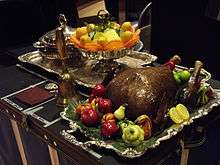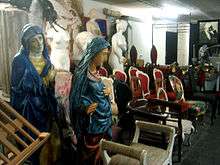Theatrical property

A prop, formally known as (theatrical) property,[1] is an object used on stage or on screen by actors during a performance or screen production. In practical terms, a prop is considered to be anything movable or portable on a stage or a set, distinct from the actors, scenery, costumes, and electrical equipment. Consumable food items appearing in the production are also considered props.[2][3][4][5]
Term
The earliest known use of the term "properties" in English to refer to stage accessories is in the 1425 CE Morality play, The Castle of Perseverance.[6][7] The Oxford English Dictionary finds the first usage of "props" in 1841, while the singular form of "prop" appeared in 1911.[8] During the Renaissance in Europe, small acting troupes functioned as cooperatives, pooling resources and dividing any income. Many performers provided their own costumes, but special items—stage weapons, furniture or other hand-held devices—were considered "company property"; hence the term "property."[9][10] Some experts however seem to think that the term comes from the idea that stage or screen objects "belong" to whoever uses them on stage.[5]
There is no difference between props in different media, such as theatre, film, or television. Bland Wade, a properties director, says, "A coffee cup onstage is a coffee cup on television, is a coffee cup on the big screen." He adds, "There are definitely different responsibilities and different vocabulary."[11]
History
The first known props were stylized hand held masks, called onkoi, used by performers in the theatre of ancient Greece and have become symbols of theatre today, known as the "comedy and tragedy masks".
On stage and backstage

The term "theatrical property" originated to describe an object used in a stage play and similar entertainments to further the action. Technically, a prop is any object that gives the scenery, actors, or performance space specific period, place, or character. The term comes from live-performance practice, especially theatrical methods, but its modern use extends beyond the traditional plays and musical, circus, novelty, comedy, and even public-speaking performances, to film, television, and electronic media.
Props in a production originate from off stage unless they have been preset on the stage before the production begins. Props are stored on a prop table backstage near the actor's entrance during production then generally locked in a storage area between performances. The person in charge of handling the props is generally called the props "master/mistress" however, varying positions also include coordinators, production assistance and interns as may be needed for a specific project.
Modern usage

The term has readily transferred to television, motion picture and video game production, where they are commonly referred to by the phrase movie prop, film prop or simply prop. In recent years, the increasing popularity of movie memorabilia (a broader term that also includes costumes) has added new meaning to the term "prop," broadening its existence to include a valuable after-life as a prized collector's item. Typically not available until after a film's premiere, movie props appearing on-screen are called "screen-used", and can fetch thousands of dollars in online auctions and charity benefits.[12][13]
Many props are ordinary objects. However, a prop must "read well" from the house or on-screen, meaning it must look real to the audience. Many real objects are poorly adapted to the task of looking like themselves to an audience, due to their size, durability, or color under bright lights, so some props are specially designed to look more like the actual item than the real object would look. In some cases, a prop is designed to behave differently from how the real object would, often for the sake of safety.
Examples of special props are:
- A prop sack representing a burlap bag, might have another black fabric bag sewn, discreetly inside the burlap, giving it strength, hiding the contents and creating a visual void to the audience view.
- A 'mop,' representing a string mop, but built out of a rectangular shape covered with fabric, so the mop can be slid across the stage to another actress as part of a musical number (as in Fiddler on the Roof, the song "Matchmaker").
- A prop weapon (such as a stage gun or a stage sword) that reads well but lacks the intentional harmfulness of the corresponding real weapon. In the theater, prop weapons are almost always either non-operable replicas, or have safety features to ensure they are not dangerous. Guns fire caps or noisy blanks, swords are dulled, and knives are often made of plastic or rubber. In film production, fully functional weapons are mostly used, but typically only with special smoke blanks with blank adapted guns instead of real bullets. Real cartridges with bullets removed are still dangerously charged which has caused several tragic instances when used on stage or film. The safety and proper handling of real weapons used as movie props is the premiere responsibility of the prop master. ATF and other law enforcement agencies may monitor the use of real guns for film and television but this is generally not necessary with stage props as these guns are permanently "plugged".
- Breakaway objects, or stunt props, such as balsa-wood furniture, or sugar glass (mock-glassware made of crystallized sugar) whose breakage and debris look real but rarely cause injury due to their light weight and weak structure. Even for such seemingly safe props, very often a stunt double will replace the main actor for shots involving use of breakaway props. Rubber bladed-weapons and guns are examples of props used by stuntmen to minimize injury, or by actors where the action requires a prop which minimizes injury.[14]
- "Hero" props are the more detailed pieces intended for close inspection by the camera or audience. The hero prop may have legible writing, lights, moving parts, or other attributes or functions missing from a standard prop; a hero prop phaser from the Star Trek franchise, for example, might include a depressible trigger and a light-up muzzle and display panel (all of which would make the hero prop more expensive and less durable). The term is also used on occasion for any of the items that a main character would carry in film and television (which are often hero props in the first sense as well). The term may sometimes be used in stage production, as many props from film find their way into theatre from common rental and purchase shops.
Design, construct and acquire
Working in coordination with the set designer, costume designer, lighting and sometimes, sound designer, this overlapping position has only in recent years become of greater importance. Props have become more and more specialized due in large part to realism as well as the rise of theatre in the round, where few sets are used and the simple prop becomes as important a design element as costumes and lighting.
Besides the obvious artistic creations made in the prop workshop, much of the work done by the property designer is research, phone searches, and general footwork in finding needed items. Prop designers are not always credited in theatre, but film credits for full staff of designers, artisans and craftsmen are much more common.
References
- ↑ Oxford Dictionaries Online "old-fashioned term for prop"
- ↑ Nesfield-Cookson, Mary (1934). Small Stage Properties and Furniture. London: G. Allen & Unwin. p. 11.
- ↑ Conway, Heather (1959). Stage Properties. London: H. Jenkins. p. 11.
- ↑ Govier, Jacquie (1984). Create Your Own Stage Props. Englewood Cliffs, NJ: Prentice-Hall. p. 8. ISBN 0-13-189044-1.
- 1 2 Harris, Margaret (1975). "Introduction". In Motley. Theatre Props. New York: Drama Book Specialists/Publishers. p. 7. ISBN 0-910-482-66-7.
- ↑ Hart, Eric (19 October 2009). "First use of "Property" in the theatrical sense". Prop Agenda. Retrieved 7 April 2013.
- ↑ Cook, Dutton (1878). "Stage Properties". Belgravia. 35. pp. 282–284.
- ↑ prop, n./6; Third edition, September 2009; online version November 2010. <http://www.oed.com:80/Entry/152851>; accessed 13 January 2011. An entry for this word was first included in New English Dictionary, 1908.
- ↑ Eric Partridge Origins: A Short Etymological Dictionary of Modern English: Second Edition. Random House 1959
- ↑ Kenneth Macgowan and William Melnitz The Living Stage. Prentice-Hall 1955.
- ↑ Wade, Blande (2010). "Through the Eyes of the Property Director". Theatre Symposium. 18: 8. ISBN 978-0-8173-7005-3. ISSN 1065-4917.
- ↑ Ian Mohr Daily Variety. Reed Business Information, February 27, 2006 "Movie props on the block: Mouse to auction Miramax leftovers"
- ↑ David James, People Magazine, Time, Inc. February 24, 2007 "Bid on Dreamgirls Costumes for Charity"
- ↑ Coyle, Richard. "A Collector's Guide To Hand Props". RACprops. Retrieved 9 July 2009.
Further reading
- Sofer, Andrew (2003). The Stage Life of Props (illust. ed.). University of Michigan Press. ISBN 0-472-06839-3. Retrieved 2009-01-30.